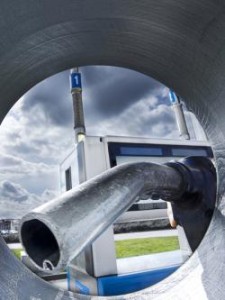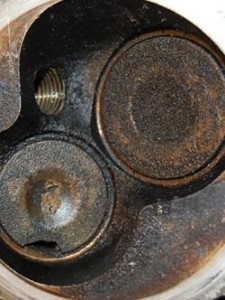Trouble with Ethanol for boaters
Will New Regulations Mean More Costly Problems for Boaters?
from The Fishing Wire
Unless you haven’t put fuel in your car in the past ten years, you’re probably familiar with the term E10. It refers to the 10 percent ethanol that is blended into the gasoline you buy at the pump. If you’ve owned an outboard-powered boat during that same time period, you are far more familiar with E10 than your over-the-road counterparts.
The introduction of ethanol into the U.S. gasoline supply was the result of an EPA regulation called the Renewable Fuel Standard, and it caused a lot of costly headaches for boaters at the 10 percent level. Now, the EPA is doubling down under intense pressure from the agri-industry’s ethanol lobby in Washington, increasing the mandated amount of ethanol in gasoline to 15 percent, a move dreaded by boaters and marine engine manufacturers alike.
Ethanol is derived from plant sources, mostly corn, and the government mandate has been a major boon to farmers and refiners. Basically, it is a fermented and refined grain alcohol that is denatured and then blended with gasoline. It initially found its way into the nation’s fuel supply as a replacement for a chemical additive called MTBE, which was used to increase octane and reduce emissions. After years of use, the EPA determined that MTBE was harmful to the environment, and the hunt for a replacement began. Domestically manufactured ethanol replaced MTBE, and was also promoted as a way to reduce the nation’s dependency on foreign oil. However, the use of ethanol in fuel came with a host of problems for marine engines and fuel systems.
At the fuel pump, it’s critical never to use E15 in a boat engine, and manufacturers say even E10 can be harmful if precautions are not taken.Not long after the introduction of E10 gasoline, boats using it began experiencing problems. Almost immediately mysterious substances began clogging fuel filters that were later identified as a byproduct of mixing fuel still in the tank containing MTBE with ethanol-blended gasoline, but that was only a harbinger of things to come. Fuel lines approved for gasoline engines on boats reacted badly with the ethanol additive and started breaking down causing clogged filters; and in cases where the problem was not identified quickly, possible fuel leaks were the result. Any sludge deposits in older fuel tanks began dissolving and were pumped into the fuel system, damaging components and making a mess of filters. And boats with fiberglass fuel tanks were subject to the added nightmare of ethanol actually eating away the resin, which required replacement of the tank and in many cases, serious damage to expensive engine components like valves, carburetors and injectors.
Why were all these problems manifesting as a result of a simple switch from MTBE to a 10 percent blend of ethanol? As mentioned, ethanol is a form of alcohol and alcohol is a highly efficient solvent. So when it is introduced into older metal fuel tanks, it gradually begins to break down accumulated sediments and washes them into the fuel system. Those same properties can cause resins and fillers used to make fiberglass fuel tanks to leach out into the fuel system where they adhere to internal engine parts. Ethanol-blended fuel can also be responsible for the decomposition of rubber gaskets and fuel lines that heretofore had been approved for use in gasoline fuel systems.
Boat and engine manufacturers took on the challenge of upgrading their products to avoid these problems going forward, and have done an admirable job. Yamaha Marine was an early leader in identifying these problems and correcting them in their popular lineup of outboard engines. They upgraded fuel systems with hoses and gaskets that are resistant to ethanol’s solvent properties. The company also developed injection systems and revised ignition modules so that Yamaha outboards can run efficiently with E10, which has a lower combustion temperature and therefore a slightly lower power output than gasoline without ethanol. Even though most of the problems with E10-blended fuels have been accounted for by outboard manufacturers, there are still some issues that are inherent to the product that continue to plague boaters.
Internal corrosion is among the issues that can result from use of high-ethanol fuels in boat motors.Ethanol is hygroscopic, which means it absorbs water from the air. While this is rarely a problem in automobiles that live on dry land and have sealed fuel systems, marine applications are another story altogether. Boats live in a moisture- and humidity-rich environment, and boat fuel systems are vented to the atmosphere. Without venting, an outboard’s fuel pump would not be able to draw fuel from the tank. Venting allows outside air to enter the tank along with moisture and humidity where it contacts the ethanol in the gas.
“Water can and will collect in your fuel, and when the concentration of water molecules reaches just one half of one percent, those molecules will bond with the ethanol in the gasoline and sink to the bottom of the tank where the fuel pick up is located,” said David Meeler, Product Information Manager, Yamaha Marine Group. “This is called ‘phase separation’ and depending on the amount of water ingested into your outboard, it can result in everything from rough running to catastrophic engine damage.”
In the new brochure titled “Maintenance Matters
– A Simple Guide for the Longevity of Your Outboard,” Yamaha offers the following recommendations for avoiding the potentially damaging effects of burning ethanol fuel in your outboard engine.
1. Be sure to use a 10-micron fuel/water separating filter—with proper flow rating for the engine—is installed in the fuel line between the tank and the outboard. This will filter out any debris that ethanol might loosen in the tank, and it will separate out and collect any water from the fuel. (Yamaha offers high-quality canister filters with large water collecting reservoirs for their outboards.) Filters should be replaced every 100 hours of operation or checked/replaced more frequently if the presence of significant water is found.
2. Add a high-quality, marine specific fuel stabilizer and conditioner to every tank of fuel. Yamalube® Fuel Stabilizer and Conditioner is a non-alcohol-based formula that helps counter some of the problems associated with ethanol blended fuels. They caution boaters about claims from some additive manufacturers stating unequivocally that, “no additive will restore stale fuel, remove water or cure ethanol-related issues.”
3. Add Yamalube® Ring Free Plus internal engine cleaner to every tank of fuel. It will do the job of keeping your fuel system clean and corrosion free.
4. Buy your gas where they sell a lot of it! Today’s ethanol-blended gasolines have a notoriously short shelf life and actually begin to degrade in a matter of days after refining and blending. Purchasing gas at a high volume retailer helps insure you are buying the freshest gas. Then be sure to add stabilizer and engine cleaner at the time of purchase. This will go a long way in helping protect your investment in your outboard engine from ethanol problems.
If you are like many boat owners who only use their boats on weekends or even less frequently during the boating season, it’s advisable to keep your fuel tank level at 7/8 full with properly stabilized, fresh fuel. Keeping your tank at that level helps prevent condensation build up in the tank while the boat is not in use. Condensation occurs when any moisture in the air in the tank condenses with changing temperatures. It is another source of water entering the fuel and bonding with the ethanol.
With all of the problems associated with the use of E10 gasoline in marine engines, you would think the federal government might do something to mitigate the effects by reducing ethanol requirements. Unfortunately, that is not the case. The EPA, under the guise of the Renewable Fuel Standard, is mandating a 50 percent increase in the use of E15 gasoline, which will further exacerbate the problems associated with ethanol in marine engines. In an interview with Martin Peters, Manager, Government Relations for Yamaha Marine in Kennesaw, Ga., he laid out the case from the marine industry against the ethanol increase, along with a dire warning for owners of existing outboard engines.
“The marine industry has determined through research and testing that E15 harms outboards by doing internal damage to moving parts such as valves and pistons – devastating, irreparable damage,” said Peters. “While Yamaha could engineer outboards that will run on E15, doing so would increase cost to the consumer without increasing consumer benefits.
“More importantly, if E15 becomes the predominately available fuel in the U.S., that would leave ‘legacy’ outboards at risk of damage,” he continued. “There are more than 10 million outboards currently in service that would be destroyed by the damaging effects of E15. As an industry, we cannot allow this to happen to consumers.
“We strongly urge consumers and members of the marine industry to make their voices heard and stop the EPA from going forward with a plan to increase the amount of ethanol in the fuel supply. They can do so by contacting the EPA—or their Congressman/Senator—directly over concerns that higher ethanol blends will have on their products or by accessing a number of marine advocacy websites such as the National Marine Manufacturers Association® (www.nmma.org).”
For more information about caring for your outboard engine, check out Yamaha’s Maintenance Matters website at:
http://maintenance.yamahaoutboards.com/



